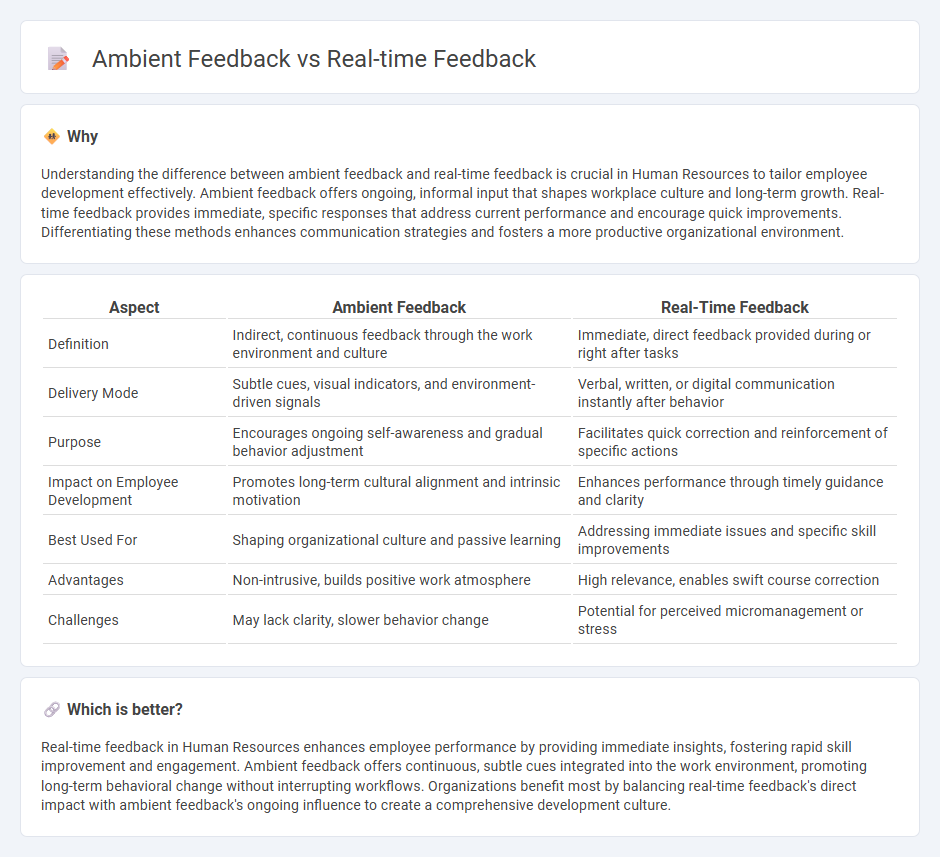
Ambient feedback leverages continuous data collection through multiple channels to provide comprehensive insights into employee performance, fostering a holistic understanding of workplace behavior. Real-time feedback, delivered immediately during or after tasks, enhances employee engagement and accelerates skill development by addressing issues promptly. Explore how integrating both feedback methods can transform your human resources strategy for superior workforce management.
Why it is important
Understanding the difference between ambient feedback and real-time feedback is crucial in Human Resources to tailor employee development effectively. Ambient feedback offers ongoing, informal input that shapes workplace culture and long-term growth. Real-time feedback provides immediate, specific responses that address current performance and encourage quick improvements. Differentiating these methods enhances communication strategies and fosters a more productive organizational environment.
Comparison Table
| Aspect | Ambient Feedback | Real-Time Feedback |
|---|---|---|
| Definition | Indirect, continuous feedback through the work environment and culture | Immediate, direct feedback provided during or right after tasks |
| Delivery Mode | Subtle cues, visual indicators, and environment-driven signals | Verbal, written, or digital communication instantly after behavior |
| Purpose | Encourages ongoing self-awareness and gradual behavior adjustment | Facilitates quick correction and reinforcement of specific actions |
| Impact on Employee Development | Promotes long-term cultural alignment and intrinsic motivation | Enhances performance through timely guidance and clarity |
| Best Used For | Shaping organizational culture and passive learning | Addressing immediate issues and specific skill improvements |
| Advantages | Non-intrusive, builds positive work atmosphere | High relevance, enables swift course correction |
| Challenges | May lack clarity, slower behavior change | Potential for perceived micromanagement or stress |
Which is better?
Real-time feedback in Human Resources enhances employee performance by providing immediate insights, fostering rapid skill improvement and engagement. Ambient feedback offers continuous, subtle cues integrated into the work environment, promoting long-term behavioral change without interrupting workflows. Organizations benefit most by balancing real-time feedback's direct impact with ambient feedback's ongoing influence to create a comprehensive development culture.
Connection
Ambient feedback and real-time feedback are interconnected in Human Resources by fostering continuous performance improvement and employee engagement. Ambient feedback provides subtle, ongoing cues within the work environment, while real-time feedback delivers immediate, actionable insights during or shortly after tasks. Together, they create a dynamic feedback ecosystem that enhances communication, supports timely development, and drives organizational productivity.
Key Terms
Continuous Performance Management
Real-time feedback in Continuous Performance Management offers immediate, specific insights that help employees adjust behaviors promptly, enhancing productivity and engagement. Ambient feedback provides ongoing, subtle cues integrated into the work environment, fostering a culture of continuous improvement without interrupting workflow. Explore how combining both feedback types can transform performance management in dynamic workplaces.
Employee Engagement
Real-time feedback in employee engagement involves immediate responses to performance, fostering quick adjustments and increased motivation, while ambient feedback provides continuous, less intrusive insights that encourage gradual improvement and a sustained sense of awareness. Companies utilizing platforms like Salesforce or Workday report up to 30% higher employee engagement when combining both feedback types, balancing urgency with ongoing development. Explore detailed strategies to enhance your organization's employee engagement through effective feedback mechanisms.
Communication Channels
Real-time feedback leverages synchronous communication channels such as instant messaging, live video calls, and phone conversations, enabling immediate responses and dynamic interaction. Ambient feedback relies on asynchronous channels like email notifications, dashboard alerts, or contextual cues integrated into user interfaces, fostering ongoing awareness without disrupting workflow. Explore how choosing the right communication channels enhances feedback effectiveness in various professional settings.
Source and External Links
Real-Time Feedback: an Explanation (and Examples) - This article explains real-time feedback as an instant communication process used to improve product development and customer satisfaction by providing immediate comments and suggestions.
What Is Real Time Feedback? - Real-time feedback is a management tool that involves providing immediate feedback to team members, enhancing team performance, cohesion, and creating a positive working environment.
Using Real-Time Feedback to Improve Employee Experience - Real-time feedback is a performance management tool that helps managers provide timely and accurate feedback to employees, improving their skills and addressing issues promptly.
 dowidth.com
dowidth.com